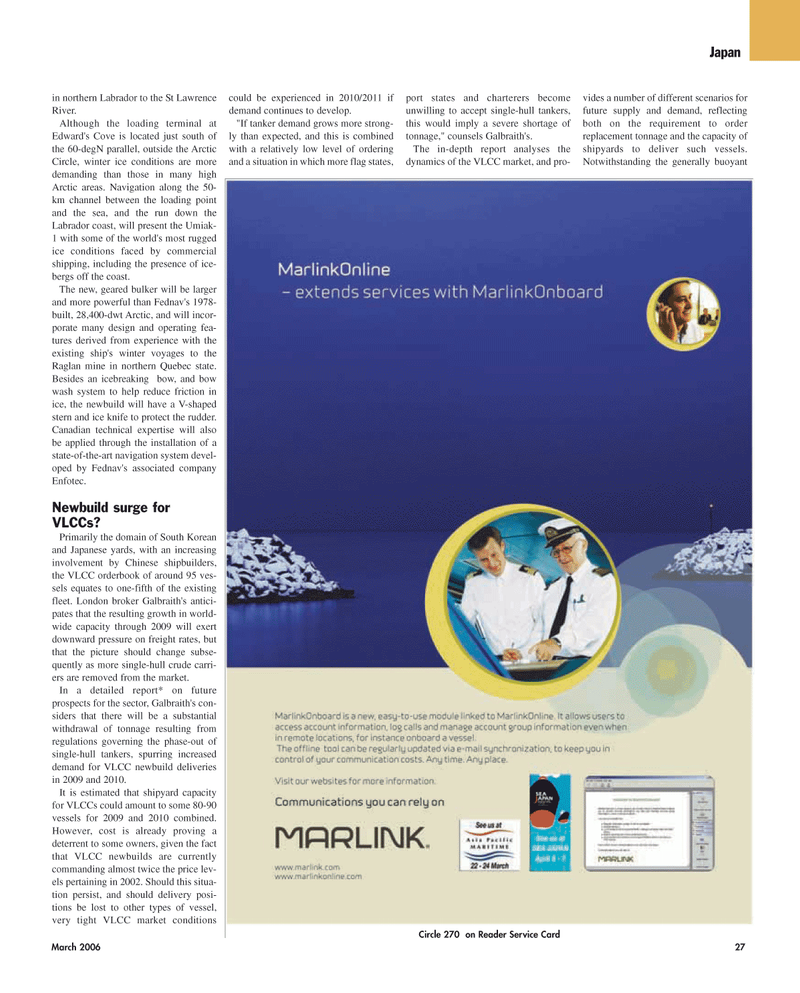
Page 27: of Maritime Reporter Magazine (March 2006)
The Training & Education Edition
Read this page in Pdf, Flash or Html5 edition of March 2006 Maritime Reporter Magazine
March 2006 27 in northern Labrador to the St Lawrence
River.
Although the loading terminal at
Edward's Cove is located just south of the 60-degN parallel, outside the Arctic
Circle, winter ice conditions are more demanding than those in many high
Arctic areas. Navigation along the 50- km channel between the loading point and the sea, and the run down the
Labrador coast, will present the Umiak- 1 with some of the world's most rugged ice conditions faced by commercial shipping, including the presence of ice- bergs off the coast.
The new, geared bulker will be larger and more powerful than Fednav's 1978- built, 28,400-dwt Arctic, and will incor- porate many design and operating fea- tures derived from experience with the existing ship's winter voyages to the
Raglan mine in northern Quebec state.
Besides an icebreaking bow, and bow wash system to help reduce friction in ice, the newbuild will have a V-shaped stern and ice knife to protect the rudder.
Canadian technical expertise will also be applied through the installation of a state-of-the-art navigation system devel- oped by Fednav's associated company
Enfotec.
Newbuild surge for
VLCCs?
Primarily the domain of South Korean and Japanese yards, with an increasing involvement by Chinese shipbuilders, the VLCC orderbook of around 95 ves- sels equates to one-fifth of the existing fleet. London broker Galbraith's antici- pates that the resulting growth in world- wide capacity through 2009 will exert downward pressure on freight rates, but that the picture should change subse- quently as more single-hull crude carri- ers are removed from the market.
In a detailed report* on future prospects for the sector, Galbraith's con- siders that there will be a substantial withdrawal of tonnage resulting from regulations governing the phase-out of single-hull tankers, spurring increased demand for VLCC newbuild deliveries in 2009 and 2010.
It is estimated that shipyard capacity for VLCCs could amount to some 80-90 vessels for 2009 and 2010 combined.
However, cost is already proving a deterrent to some owners, given the fact that VLCC newbuilds are currently commanding almost twice the price lev- els pertaining in 2002. Should this situa- tion persist, and should delivery posi- tions be lost to other types of vessel, very tight VLCC market conditions could be experienced in 2010/2011 if demand continues to develop. "If tanker demand grows more strong- ly than expected, and this is combined with a relatively low level of ordering and a situation in which more flag states, port states and charterers become unwilling to accept single-hull tankers, this would imply a severe shortage of tonnage," counsels Galbraith's.
The in-depth report analyses the dynamics of the VLCC market, and pro- vides a number of different scenarios for future supply and demand, reflecting both on the requirement to order replacement tonnage and the capacity of shipyards to deliver such vessels.
Notwithstanding the generally buoyant
Circle 270 on Reader Service Card
Japan
MR MARCH2006 #4 (25-32).qxd 3/2/2006 11:40 AM Page 27

 26
26

 28
28
